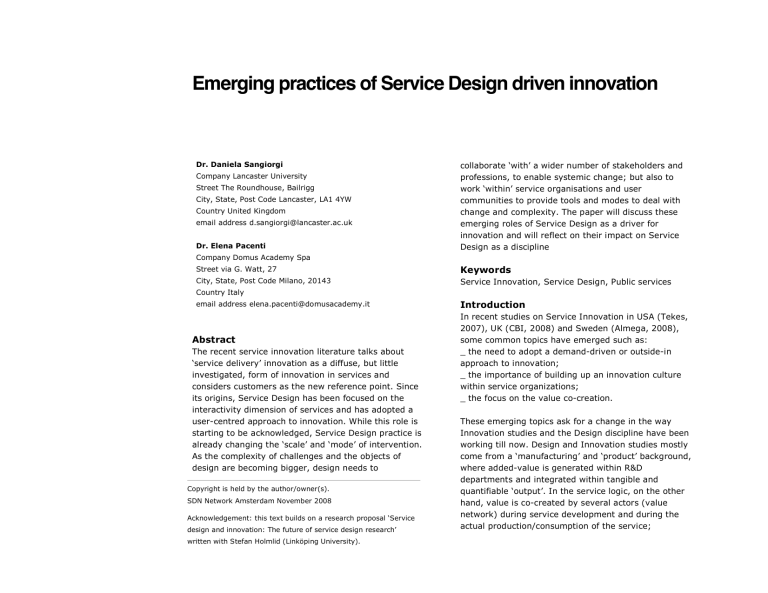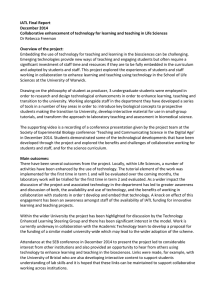Emerging practices of Service Design driven innovation

Emerging practices of Service Design driven innovation
Dr. Daniela Sangiorgi
Company Lancaster University
Street The Roundhouse, Bailrigg
City, State, Post Code Lancaster, LA1 4YW
Country United Kingdom email address d.sangiorgi@lancaster.ac.uk
Dr. Elena Pacenti
Company Domus Academy Spa
Street via G. Watt, 27
City, State, Post Code Milano, 20143
Country Italy email address elena.pacenti@domusacademy.it collaborate ‘with’ a wider number of stakeholders and professions, to enable systemic change; but also to work ‘within’ service organisations and user communities to provide tools and modes to deal with change and complexity. The paper will discuss these emerging roles of Service Design as a driver for innovation and will reflect on their impact on Service
Design as a discipline
Keywords
Service Innovation, Service Design, Public services
Abstract
The recent service innovation literature talks about
‘service delivery’ innovation as a diffuse, but little investigated, form of innovation in services and considers customers as the new reference point. Since its origins, Service Design has been focused on the interactivity dimension of services and has adopted a user-centred approach to innovation. While this role is starting to be acknowledged, Service Design practice is already changing the ‘scale’ and ‘mode’ of intervention.
As the complexity of challenges and the objects of design are becoming bigger, design needs to
Copyright is held by the author/owner(s).
SDN Network Amsterdam November 2008
Acknowledgement: this text builds on a research proposal ‘Service design and innovation: The future of service design research’ written with Stefan Holmlid (Linköping University).
Introduction
In recent studies on Service Innovation in USA (Tekes,
2007), UK (CBI, 2008) and Sweden (Almega, 2008), some common topics have emerged such as:
_ the need to adopt a demand-driven or outside-in approach to innovation;
_ the importance of building up an innovation culture within service organizations;
_ the focus on the value co-creation.
These emerging topics ask for a change in the way
Innovation studies and the Design discipline have been working till now. Design and Innovation studies mostly come from a ‘manufacturing’ and ‘product’ background, where added-value is generated within R&D departments and integrated within tangible and quantifiable ‘output’. In the service logic, on the other hand, value is co-created by several actors (value network) during service development and during the actual production/consumption of the service;
2 innovations are often intangible in nature and hard to measure. Instead of relying on the creativity of single individuals, innovation is also moving toward more open (open innovation) and participatory models (codesign). Complex contemporary issues such as sustainability, ageing, chronic diseases, security, etc. require multidisciplinary and holistic approaches. At the same time users’ behavior and participation (Demos,
2008) are recognized as fundamental for the success of many services and campaigns. This significant shift toward services and the complexity of contemporary society therefore ask for new design and innovation skills and knowledge.
Service Design practice is already changing the ‘scale’ and ‘mode’ of intervention. As the complexity of challenges and the objects of design are becoming bigger designers have started to collaborate ‘with’ a wider number of stakeholders and professions, to enable systemic change (Brass, 2008); but also to work
‘within’ service organisations and user communities to provide tools and modes to deal with change and complexity and to enable the development of an
‘innovation culture’.
In this paper we would like to report these emerging practices as areas of need for theory building. In particular there are at least three interrelated areas of innovation that need further investigation and theory development:
1) Service interactions : new or improved delivery modes and customer experiences are the most frequent kind of service innovations. On a theoretical level, this innovation area has been built on a hypothesis of analogy between Service Design and Interaction
Design, but apart from an initial Italian PhD research
(Pacenti, 1998) and some work in Linköping and
Carnegie Mellon (Holmlid and Evenson, 2007), this analogy has been little investigated.
2) Co-creation within complex systems : this innovation area refers to the strict interdependency between service innovation and organizational change. Service organizations are considered as complex social systems often made up of a network of stakeholders: the socalled ‘value systems’ (Ramirez, 2008). When designers work with and within service organizations, often with the intention to instill an innovation culture, they need to understand, deal with and visualize the complexity of the organizational dynamics. Service Design research has touched these topics, creating first theoretical connections with Actor-Network theory (Morelli, 2003),
Activity Theory (Sangiorgi, 2004), and Organisational
Change Theory (Junginger and Sangiorgi, forthcoming).
3) Platforms for participation : this innovation area refers to the significant work made on the topics of social innovation
(Manzini, 2007; Meroni, 2007; Thackara, 2005) and to the wider debate on Public Services reform. In this area the role of design is increasingly becoming the one of facilitating participatory design processes and providing platforms for people to change and improve their life. This area could be further explored deepening the connections with participatory design and behavioral sciences.
A case study: Service innovation in the public sector
This chapter uses an Italian case study of service innovation in the public sector _ implementation of a new service model for the job centres for the regional authority _ to reflect on the role service design is
3 currently playing and how the three areas of innovation mentioned above are strictly interconnected.
In the Italian context the public sector has no preexisting knowledge and understanding of the practice of
Service Design as a discipline; Domus Academy
Research Centre (DARC) has been assigned to design the communication of a new service idea ( dote lavoro ), therefore working on one of the service interface dimensions. The role of service designer as the
‘director’ of the overall service performance had to be negotiated working with and within a highly complex and changing political system.
The new service model provides incentives and services to unemployed citizens to find a job through job centers. The novelty of dote lavoro is that public money is given to final users instead of to job centers to allow citizens to choose what services to buy. This implies a significant cultural and behavioral change both for the service organization and for citizens.
The public body started a pilot project with two types of incentives; the new service formula was advertised in the job centers through leaflets, posters, etc. An internet-based platform and a complex guide of more than 50 pages were given to the operators to help them with the service procedure.
DARC designed the tools needed to support the service operators’ job and the communication campaign to build the identity of the new service model.
Service evidences for the job centers and clear guidelines for the service identity have been developed.
The ability of sketching and making service ideas and processes visible revealed to be the most effective skill to promote and communicate the role and potential impact of service design in the project; designing adequate supporting information and dialoguing tools for the operators (e.g. notational tools such as iconic workflow storyboarding) became the main driver to improve the service quality and to convince the public body of the necessity to re-design the overall interface to implement the new procedure.
The initial role to innovate the elements of the service interface brought DARC to deal with the wider organizational constraints of the public body .
Service designers’ role has moved from designing the service interface to the one of facilitating the service design and implementation process; this by: 1. defining scalable design objectives (as the service interface is linked to different decisional centers it is necessary to anticipate what are the feasible set of interventions and how they are linked to each other), 2. adopting a flexible and adaptive service design approach, anticipating the main steps of the implementation process and producing dialoguing tools to make objectives and outcomes clear (transparency), 3. participating to some decisional processes.
Together with the need to plan the scalability and flexibility of design objectives and tools to negotiate design achievements, the service design team had to consider the issue of participation as well, both on the staff and on the user side (behavioral change). This required focusing on ‘learning’ processes, supporting transparency of service processes and maintaining engagement and interest along the way.
4
Through the on-sites analysis, DARC helped Regione
Lombardia to understand that the job centers were the weakest link in the achievement of service quality, due to a lack of commitment and opaque political framework. This caused DARC to be automatically involved into a work program with the job centers to share, understand and agree with the ongoing change.
Final considerations
As shown briefly in this service project, innovation at the service interface level often impacts on wider organizational dynamics, touching issues such as identity, learning, motivation and participation; this is particularly true when new service models are introduced. There is still little design research and theoretical investigation on these dimensions of service innovation; Service Design research needs to generate design theory to ground and support the ongoing development of Service Design discipline; the reflection on existing practices needs to be complemented by the connection with, interpretation and adaptation of multidisciplinary knowledge on relevant areas such as complexity theory, organizational change, behavioral science, innovation theories, etc.
References and Citations
Almega (2008). Innovativa tjänsteföretag och forskarsamhället: Omaka par eller perfect match.
Bradwell, P., Marr, S. (2008). Making the most of collaboration an international survey of public service co-design. Demos report 23
CBI (2008) Excellence in service innovation.
CBI/QinetiQ report on innovation in UK service sector businesses.
Holmlid, S., & Evenson, S. (2007). Prototyping and enacting services: Lessons learned from humancentered methods. QUIS 10. Orlando, Florida.
Manzini, E. (2007). Design research for sustainable social innovation in: Michel R. (edited by), Design
Research Now: Essays and Selected Projects,
Birkhäuser Basel.
Meroni, A. (2007). Creative Communities. People inventing sustainable ways of living. Milano:
Edizioni Polidesign
Morelli, N. (2003). Product-Service Systems : A
Perspective Shift for Designers. A Case Study: the
Design of a Telecentre. Design Studies 24(1):73-99
Pacenti, E. (1998) Il progetto dell’interazione nei servizi, PhD in Industrial Design
Ramirez R. and Mannervick U. (2008) Designing Valuecreating Systems, in Kimbell L. and Seidel V. P.
(Eds.), Designing for Services, Said Business
School, University of Oxford, 2008
Sangiorgi, D. (2004). Il Design dei servizi come Design dei Sistemi di Attività, PhD in Industrial Design
Tekes (2007). Seizing the White Space: Innovative
Service Concepts in the United States, Technology
Review 205/2007
Thackara, J. (2005), In the Bubble: designing in a complex world. The MIT Press, Cambridge, MA.






